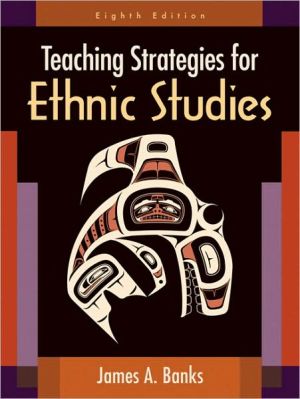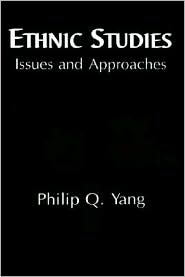Teaching Strategies for Ethnic Studies
Teaching Strategies for Ethnic Studies, Eighth Edition\ James A. Banks is Kerry and Linda Killinger Professor of Diversity Studies and Director of the Center for Multicultural Education at the University of Washington, Seattle. http://depts.washington.edu/centerme/home.htm\ “My students love the book [and] tell me that they will use the techniques for working with diverse students in their classes.”\ —Joyce Nichols, University of West Florida\ Written by the leading authority in the field,...
Search in google:
Written by the leading authority in the field, the Eighth Edition of this classic text has been rewritten and updated to reflect current and emerging theory, research, and scholarship in the fields of ethnic studies and multicultural education.Divided into five parts, Teaching Strategies for Ethnic Studies emphasizes that the main goal of the multicultural curriculum should be to help students develop the ability to make reflective decisions so that they can, through thoughtful action, influence their personal, social, and civic worlds and help make them more democratic and just. Booknews Banks's (multicultural education, U. of Washington, Seattle) text is designed to help teachers conceptualize, design, and implement a democratic, multicultural curriculum which respects and honors diversity while simultaneously promoting national unity. The seventh edition incorporates concepts, perspectives and issues in multicultural education emerging since the publication of the sixth edition in 1997; the addition of information from the 2000 U.S. Census; and extensive revisions and additions to the bibliographies and resource appendixes. For practicing teachers and teacher trainees. Annotation c. Book News, Inc., Portland, OR (booknews.com)
PrefacePt. 1Goals, Concepts, and Instructional Planning11The Multicultural Curriculum: Rationale, Trends, and Goals3The Persistence of Ethnicity in American Society3The Complexity of Ethnicity in American Society9Ethnicity and Individuals10Ethnic Studies: Assumptions and Practices12Ethnic and Cultural Studies: A Process of Curriculum Reform172Developing a Multicultural Curriculum32The Interdisciplinary - Conceptual Approach32Studying Culture: An Example of the Interdisciplinary - Conceptual Approach33Incorporating Elements from Science and Mathematics into the Multicultural Curriculum33The Forms of Knowledge37An Effective Multicultural Curriculum493Key Concepts for the Multicultural Curriculum55Criteria for Selecting Interdisciplinary Concepts55Interdisciplinary Concepts58The Movement of Ethnic Groups824Planning the Multicultural Curriculum91Identifying Key Concepts and Organizing Generalizations91Identifying Intermediate-Level Generalizations92Identifying Low-Level Generalizations96Concepts and Generalizations in the Multicultural Curriculum97Teaching Strategies and Materials99The Value Component of the Multicultural Curriculum100Approaches to Moral Education103a Value Inquiry Model106Providing Opportunities for Personal, Social, and Civic Action108Finding Students Resources109Guidelines for Evaluating and Selecting Multicultural Materials111Pt. 2The First Americans and African Americans: Concepts and Strategies1215American Indians: Concepts, Strategies, and Materials123Early Life in the Americas124The Westward Journeys134American Indians and Federal Policy137Self-Determination and the Challenge to Termination139Fishing Rights and Land Claims140American Indians Today1416Native Hawai'ians: Concepts, Strategies, and Materials160Native Hawai'ians: Before European Contact161European Contact163Native Hawai'ians Today1697African Americans: Concepts, Strategies, and Materials187African Explorers in America187The Slave Trade191The Colonization Movement197The Civil War and Reconstruction199World War I204Organizations204World War II and the Years After205The Civil Rights Movement of the 1960s and 1970s207Pt. 3European Americans: Concepts and Strategies2338European Ethnic Groups: Concepts, Strategies, and Materials235Spaniards in the Americas240More Europeans Come to America241The Southern and Eastern European Immigrants247European Ethnic Groups in U.S. Society253The New Ethnicity254White Ethnic Groups Today: Into the Twilight of Ethnicity?2569Jewish Americans: Concepts, Strategies, and Materials273Historical Roots274The American Revolution278German-Jewish Immigration280The New Immigration285The Interwar Period286Jewish Americans Today288Pt. 4Hispanic Americans: Concepts and Strategies305Central and South Americans305Demographic Characteristics of Hispanics306Diversity among Hispanics30610Mexican Americans: Concepts, Strategies, and Materials311The Spanish Conquest313The Mexican American War318North from Mexico320Violence and Race Riots323The Chicano Movement324The Militant Chicano Movement326Mexican Americans Today32711Puerto Ricans in the United States: Concepts, Strategies, and Materials345The Island Background347United States Rule351The Commonwealth of Puerto Rico353Life on the Mainland356The Puerto Rican Mainland Community360The Future36212Cuban Americans: Concepts, Strategies, and Materials376Cuban Immigrants to the United States378Life in Cuba381Departure384The Mariel Immigrants of 1980385The Cuban Rafters of 1994387The Case of Elian Gonzalez388Adaptation to Life in the United States389The Second Generation393Cuban Americans Today394Pt. 5Asian Americans and Arab Americans: Concepts and Strategies40513Asian Americans: Concepts, Strategies, and Materials407Problems with the Model Minority Concept407Rapid Increases in the Asian American Population408Korean Americans409Asian Indian and Pakistani Immigrants410Southeast Asian Americans410Asian Americans: A Diverse Group411The Chinese, Japanese, and Filipino Americans: Overview412Chinese Americans414Japanese Americans421Filipino Americans43014Arab Americans: Concepts, Strategies, and Materials461Who Is an Arab?462Arabs in History: Their Links to the West464Early Arab Immigration to the United States464Assimilation and the Effects of Immigration: Restrictions on the Arab American Community469The Post-1965 Immigrants470Muslims in America471Changing Patterns of Assimilation473Anti-Arab Stereotyping473Anti-Arab Hate Crimes475New Arab American Activism: The Maturing of an Ethnic Community476The Contributions of Arab Americans to American Life478Arab Americans Today479App. AEthnic Groups in U.S. History: A Chronology of Key Events491App. BInternet Resources for Teaching about Ethnic and Cultural Diversity499App. CVideotapes and CD-ROMs on Multicultural Education and U.S. Ethnic Groups515App. DThe Carter G. Woodson Award Books521App. ETwenty Classic and Landmark Books in Ethnic Literature523Index525
\ BooknewsBanks's (multicultural education, U. of Washington, Seattle) text is designed to help teachers conceptualize, design, and implement a democratic, multicultural curriculum which respects and honors diversity while simultaneously promoting national unity. The seventh edition incorporates concepts, perspectives and issues in multicultural education emerging since the publication of the sixth edition in 1997; the addition of information from the 2000 U.S. Census; and extensive revisions and additions to the bibliographies and resource appendixes. For practicing teachers and teacher trainees. Annotation c. Book News, Inc., Portland, OR (booknews.com)\ \

